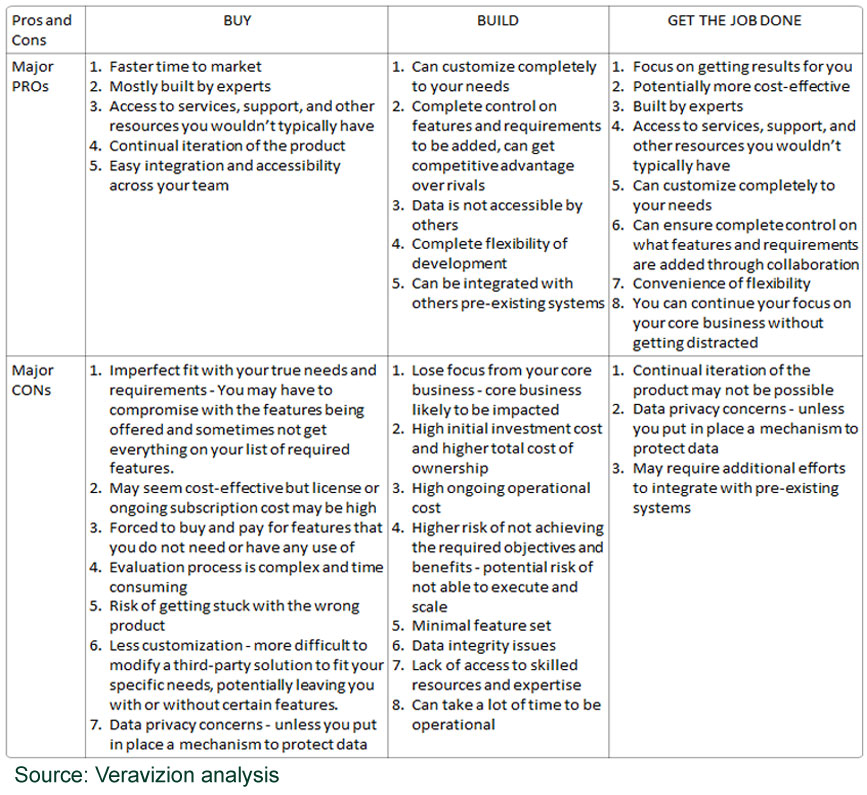To succeed in business and to achieve your professional goals, you need to be able to do two things:
- Make the right decisions
- To be able to justify the right decisions to stakeholders to take them forward
Making the right decisions helps because it saves time and money. Besides, it helps you avoid heartburn caused by the consequences of making wrong decisions. This is especially true when there is a lot at stake in that decision.
Nonetheless, making the right decisions is not enough.
It is equally important to be able to justify the right decisions to get buy-in.
Why?
It doesn’t matter if a decision is right if you cannot get buy-in to implement it.
Do all situations require decision-making?
No, not all.
There is no decision to make in a TINA (“There is no alternative”) situation.
However, the decision-making process kicks in when you have two or more options.
Businesses routinely have to make decisions like Buy-Build, Invest-Hold-Divest, or Strategic Transformation-Operational Excellence.
It becomes hard, complex, and stressful, if the options are similar to one another.
Some examples:
- Introduce a new product line or stretch the existing product line.
- Whether your company should invest in improving existing technical capabilities or hiring technical talent from outside.
- Consulting firms in online retail having to decide whether to advise a client to invest more in technology or in physical stores.
Decision-Making
In essence, the decision making process involves the following five aspects – Objectives, Options, Process, Timelines, and Stakeholders:
- Why do you need to make a decision – the objective(s)?
- Are your objectives clear? Do your objectives align with those of your colleagues or do they contradict?
- What different choices do you have – the options?
- Have you considered all possible available options for evaluation? Are these options very similar to one another?
- How do you make the decision – the process?
- Is it opinion-based (aka gut-feel based) or facts-based (aka data-driven)?
- When do you need to make the decision – the timeline?
- Is your decision-making quick enough or is it time-consuming?
- Who do you need to get the buy-in from – the stakeholders?
- Can you justify your decision to the stakeholders to get their approval for implementation?
Ideally, businesses must make decisions that are organisation-objective-oriented, facts-based, quick and efficient, and unbiased. Such decisions are invariably optimal for the business.
However, in real-life business situations, decision-making can be tricky:
The objectives of people involved in decision-making may not always align. Thus, they may not arrive at a decision at all.
Personal biases may interfere with business objectives, so the end decision may be unfairly influenced.
The time taken to make a decision may be so long that the particular business situation itself might change in the course of taking the decision, rendering the decision irrelevant.
The subjective process – basing decisions on people’s opinions rather than data – is difficult to justify to get buy-in.
Thus, in reality, businesses tend to make decisions that are subjective, opinion-based, time-consuming, and biased.
Such decisions tend to be highly sub-optimal. They do not invoke the confidence required to invest time, money, and resources to take them forward for implementation.
A decision made in this manner is full of risk and uncertainty.
Guess what?
Risk and Uncertainty are the two things business executives do not like, and want to minimize.
That is why businesses and other organisations look to external management consultants for help in making decisions.
It helps them manage the risk and uncertainty involved in the decision-making process and in the aftermath.
How management consultants help in decision-making?
Management consultants are extremely objective-oriented. They are adept at working with specific details keeping the big-picture in mind, and leaving out extraneous details.
They are highly analytical. It is their job to ensure completeness and correctness of analysis. They apply specialised skills, tools, and techniques designed to analyze different options. Moreover, they leverage their cross-domain expertise acquired from executing similar engagements from the past.
They bring an external, objective perspective. They trust data and facts more than people opinions. Relying on data removes any personal (emotional) bias.
They are particularly sensitive to the urgency of making a decision. They acknowledge that a timely decision is more important than a perfect one*.
Very importantly, management consultants arrive at a decision in an analytical and logical manner. Moreover, they help in explaining and justifying the decision to stakeholders with the help of facts and data.
A decision made in this manner raises the confidence level to commit organizational resources towards its implementation.
This is why businesses and other organizations hire consultants in their decision-making.
How do you make decisions in your business or professional world?
*One important side-note here:
In this aspect, American decision-making differs from German decision-making. In the American business context, external forces like customer request or market need often guide decision-making. So, they think that it is better to make a suboptimal decision quickly, rather than make a better or optimal decision too slow or too late.
On the contrary, Germans believe that the time allotted to a decision should be determined by the nature of the decision. They believe that it is not dictated by external pressures such as customer request or market need or competitor actions. [Source: commentator John Otto Magee on differences in American and German decision-making process]
Author: Sumit Patil
Related Posts:
- Buy, Build, or Get the job done?
- How Deliberate Strategy Can Be the Working Strategy!
- How can we make difficult decisions?
<– How will you measure your business, and life
Are you survival-oriented or a growth-oriented executive? –>
You can also subscribe to our blog – Veracles – to receive interesting articles and insights in email. We would love to read your perspectives and comments on that.
Do follow Veravizion on LinkedIn, Twitter or Facebook to receive easy updates.
Cover photo credit: Kan Chana


